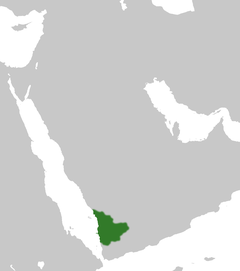The Sabean colonisation of Africa was a process of colonization by Sabeans that occurred in the Horn of Africa during the first millennium BC.[1]
 | |
| Date | The Kingdom of Saba in its later days |
|---|---|
| Location | Modern day Ethiopia and Eritrea |
History edit
One of the oldest colonisation process in history occurred around 1000 BC, the Sabeans of southern Arabia, with a civilization based on agriculture, began to colonize the highlands of northern Ethiopia and Eritrea.[2][3][4][5]
Impact and legacy edit
The Sabean occupation and influence allowed for Ethiopia to develop several civilizations like D'mt as well as the Kingdom of Aksum and left a very important mark in Ethiopian history and culture, a team of German archaeologists also recently concluded that all fundamental characteristics of Aksumite society derived from earlier populations in the Near East and South Arabia.[6] Cultural transmission from the Sabean region to the Horn of Africa extended beyond architecture and stone-masonry, reaching far into the sociopolitical, religious, and cultic spheres[7][8] The Sabean character of the pantheon is clearly evident in the worship of 'Almaqah, to whom, in addition to the Great Sabean Temple at Yeha,[9] four other sanctuaries are known. Some of these are accompanied by the building dedications of Sabean stonemasons and can be identified archaeologically.[10] Many other archaeological sites of this period in Ethiopia where some inscriptions have also been found which were executed in a Sabean-Himyaritic script, near Makalle, for example where a seated female figure was found with a South Arabian inscription on the pedestal which also makes reference to South Arabia.[11] Older inscriptions were found at Yeha, which some scholars identify with Ava, a city built by Sabean colonists, and which apparently fell into decay after the building of Aksum the "Sacred City of the Ethiopians."[12] Not only Yeha but also the ancient city of Aksum is considered by some scholars to have been founded by these Sabeans,[13] where old Sabaic inscriptions have also been found.[14]
See also edit
References edit
- ^ Japp, Sarah; Gerlach, Iris; Hitgen, Holger; Schnelle, Mike (2011). "Yeha and Hawelti: cultural contacts between Sabaʾ and DʿMT — New research by the German Archaeological Institute in Ethiopia". Proceedings of the Seminar for Arabian Studies. 41: 145–160. ISSN 0308-8421. JSTOR 41622129.
- ^ The Babylonian and Oriental Record. D. Nutt. 1894. p. 107.
- ^ Japp, Sarah; Gerlach, Iris; Hitgen, Holger; Schnelle, Mike (2011). "Yeha and Hawelti: cultural contacts between Sabaʾ and DʿMT — New research by the German Archaeological Institute in Ethiopia". Proceedings of the Seminar for Arabian Studies. 41: 145–160. ISSN 0308-8421. JSTOR 41622129.
- ^ Aethiopica: International Journal of Ethiopian Studies. Harrassowitz Verlag. 2006. p. 283.
- ^ Robertshaw, Peter (1990). A History of African Archaeology. J. Currey. p. 96. ISBN 978-0-85255-065-6.
- ^ Robertshaw, Peter (1990). A History of African Archaeology. J. Currey. p. 96. ISBN 978-0-85255-065-6.
- ^ Radner, Karen; Moeller, Nadine; Potts, Daniel T. (2023-04-07). The Oxford History of the Ancient Near East: Volume V: the Age of Persia. Oxford University Press. p. 352. ISBN 978-0-19-068766-3.
- ^ Bonsall, James (2019-09-02). New Global Perspectives on Archaeological Prospection: 13th International Conference on Archaeological Prospection, 28 August – 1 September 2019, Sligo – Ireland. Archaeopress Publishing Ltd. p. 180. ISBN 978-1-78969-307-2.
- ^ Ireland, Royal Anthropological Institute of Great Britain and (1895). Journal of the Royal Anthropological Institute. p. 208.
Some scholars consider the temple at Yeha to be the work of these Sabean colonists.
- ^ Radner, Karen; Moeller, Nadine; Potts, Daniel T. (2023-04-07). The Oxford History of the Ancient Near East: Volume V: the Age of Persia. Oxford University Press. p. 353. ISBN 978-0-19-068766-3.
- ^ Daum, Werner (1987). Yemen: 3000 Years of Art and Civilisation in Arabia Felix. Penguin Books Australia. p. 413. ISBN 978-3-7016-2292-4.
- ^ Ireland, Royal Anthropological Institute of Great Britain and (1895). Journal of the Royal Anthropological Institute. p. 208.
- ^ Cliffe, Lionel; Davidson, Basil (1988). The Long Struggle of Eritrea for Independence and Constructive Peace. The Red Sea Press. p. 68. ISBN 978-0-932415-37-0.
- ^ The Athenaeum. J. Lection. 1894. p. 88.
Sabean inscriptions brought from Aksum and Yeha